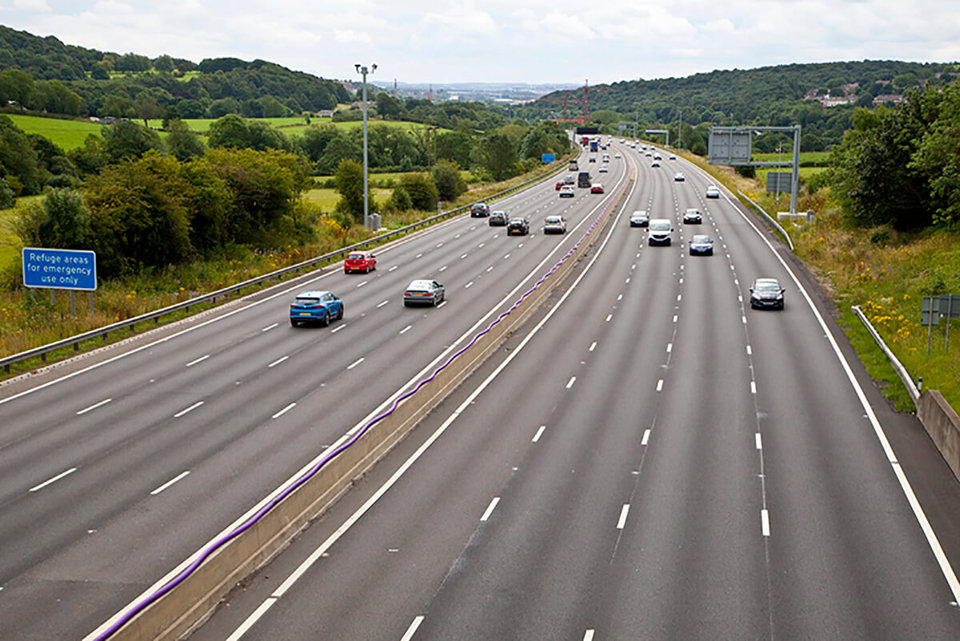Converting the hard shoulder into a running lane does not present an unacceptable level of risk, the Government has claimed.
Traffic on the strategic road network is expected to increase by up to 60% by 2040 and the Government sees smart motorways as a way of addressing this growth, without incurring the costs of traditional motorway widening.
In all lane running, the latest version of smart motorways, the hard shoulder is used as a live lane of traffic. Previous schemes have only used the hard shoulder at peak times or to deal with congestion.
Plans are in place to permanently convert the hard shoulder into a running lane on around 300 miles of motorway, with Highways England overseeing a programme of 30 schemes costing £6 billion over the next nine years.
But, MPs and motoring groups say the Government should call a halt to the programme while major safety concerns exist.
The Transport Select Committee published a report in June which concluded that the permanent loss of the hard shoulder in all lane running schemes was an “unacceptable price to pay” to improve capacity.
However, in its official response to the committee’s report released today (Thursday, September 29), the Government says that the evidence for all lane running does not suggest safety concerns, instead it claims that it shows a “reduction in collision and casualty rates”.
It continued: “The safety evidence supports the pre-scheme assessments and indicates that the current high level of safety performance on our motorways is being maintained.”
MP Louise Ellman, chair of the Transport Select Committee, accused the Department for Transport (DfT) of "blatantly ignoring the safety concerns" set out in its report.
“The Committee isn’t arguing with the Government about the need for more capacity on our motorways, or their statement that motorways are our safest roads. We support smart motorways such as the M42 scheme," she said.
“But we take real issue with the Government’s assertion that all lane running schemes on motorways are no different to other types of roads without hard shoulders. Motorways are a different class of road and drivers have different expectations when using them.”
In its response, the Government acknowledged the need for “more effective engagement to improve public perception” and to “raise road user awareness of the differences of all lane running”.
But, it added this was already underway, with a new national information campaign covering key themes such as Red X compliance, Emergency Refuge Areas (ERAs) and the importance of appropriate vehicle checks, launched by Highways England in July.
Highways England has also started a national study to identify ERA usage across England, which will help target improvements, the Government said.
Meanwhile, Highways England has committed to review ERA spacing as part of a broader approach to reduce the frequency and risk associated with live lane stops.
The AA welcomed the review of the spacing of ERAs after a poll of its members revealed four out of five (79%) felt motorways were more dangerous due to the removal of the hard shoulder.
AA president Edmund King said: “We are pleased that the Government is willing to review the length and spacing of Emergency Refuge Areas on current and future schemes.”
However, he added: “We believe the recently announced plans for the 32-mile stretch of the M4 should be immediately reviewed to incorporate the potential for more and longer ERAs.”
The AA survey came after a survey of RAC members, who had broken down on all lane running sections of motorway, found awareness of ERAs was poor, with only 28% saying they could see one when breaking down and one in four not realising they even existed.
The same survey also found that motorists breaking down on smart motorways felt more at risk on all lane running sections than they did on dynamic hard shoulder ones.
RAC chief engineer David Bizley said: “We desperately need increased capacity on our busiest sections of motorway to ease congestion and improve journey times for all, but safety must not be comprised in the process.
“Smart motorways are clearly part of the solution, but we have always said dynamic hard shoulder schemes, where hard shoulder is only used as a running lane at busy times, provide the best compromise between increased capacity and keeping drivers, their passengers and roadside workers safe.
“The all lane running configuration is, however, being rolled out by the Government as the scheme of choice and we therefore need to focus on making that as safe as possible by increasing the frequency of emergency refuge areas.”
Read more about the Government’s response to the Transport Select Committee report in the next edition of Fleet News.



















Login to comment
Comments
No comments have been made yet.